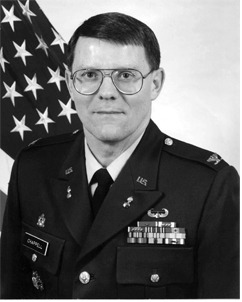Colonel
Samuel L. Chappell
 Born in 1946 in
Wyandotte, Michigan, Samuel L. Chappell joined the Army in 1969 and was commissioned upon completing Officer
Candidate School. He served as Chief, Automatic Data Processing Team, US Army Management Systems Support
Agency, Office of the Chief of Staff of the Army from 1970 to 1972. Following a tour in Thailand as Chief,
Maintenance Division, US Army Maintenance Activity, he returned to the States in 1973 and joined the
Management Systems Support Agency again as Chief of the Operations Research/Systems Analysis Team.
Born in 1946 in
Wyandotte, Michigan, Samuel L. Chappell joined the Army in 1969 and was commissioned upon completing Officer
Candidate School. He served as Chief, Automatic Data Processing Team, US Army Management Systems Support
Agency, Office of the Chief of Staff of the Army from 1970 to 1972. Following a tour in Thailand as Chief,
Maintenance Division, US Army Maintenance Activity, he returned to the States in 1973 and joined the
Management Systems Support Agency again as Chief of the Operations Research/Systems Analysis Team.
After graduation from the Ordnance Officer Advanced Course, Chappell served in Germany from 1977 to 1980, first as Chief of the Supply and Maintenance Division, G4, 59th Ordnance Brigade, where he rewrote the supply and maintenance regulations, and then as Commander, Company D, 708th Maintenance Battalion, 8th Infantry Division. In 1980, he graduated from the Command and General Staff College and returned to Germany to serve as the 8th Infantry Division Materiel Management Officer. Following graduation from the Armed Forces Staff College in 1982, he was selected by the Chief of Ordnance to serve as Chief, Management Division, US Army Ordnance Center and School. In this position, he was instrumental in reestablishing the Office of the Chief of Ordnance, developing a new Ordnance Vision, and establishing the Ordnance Magazine.
From 1984 to 1985, Chappell served as Executive Officer of 702nd Maintenance Battalion, 2nd Infantry Division, Korea. He returned to the States in 1986 to attend the Program Managers' Course and became Assistant Program Manager for Light Tactical Vehicles, responsible for the billion-dollar fielding of the High Mobility Multipurpose Wheeled Vehicle. In 1987, he assumed command of the 801st Maintenance Battalion, 101st Airborne Division, Fort Campbell, where he improved combat readiness by increasing the unit's air assault qualification rate, instituting night training, and conducting hundreds of air assault logistics missions.
Following graduation from the Army War College in 1990, he became Chief, Ordnance Branch, Officer Personnel Management Directorate, PERSCOM, where he established a reputation for his fairness and ability to balance the officers' personal preferences with mission demands in making assignments during the turbulence associated with the build-up for DESERT STORM and the force reductions that followed.
In 1992, Chappell took command of the 101st Corps Support Group at Fort Campbell, where he assumed responsibility for 2,500 Soldiers in maintenance, supply, and medical units and honed the group's proficiency during more than 20 deployments. In 1994, he was assigned to the Office of the Deputy Chief of Staff for Logistics (ODCSLOG); in this assignment, he was involved in the reorganization and consolidation of three USAREUR divisions into one and directed the retrograde of the excess materiel for overhaul and redistribution. Subsequently, he served as the Deputy Director, Logistics Integration Agency, ODCSLOG, and was the catalyst and driving force in developing Army's logistics transformation and modernization initiative often referred to as the Army's "Revolution in Military Logistics."
Chappell culminated his military career as Chief of Staff, Army Chair, and Professor of Military Strategy and Strategic Logistics at the National Defense University. During his tenure at the University, he designed an elective course entitled "Joint Revolution in Military Logistics" that emphasized the need for transforming military logistics throughout the Department of Defense.
Colonel Chappell retired in 2000 after more than 30 years of distinguished service to the Army and the Ordnance Corps